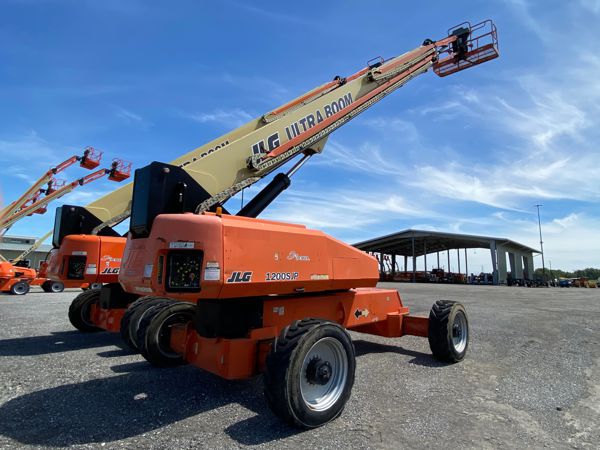
Aerial lifts are widely used equipment for accessing elevated areas on a platform. They cover a variety of types, including boom lifts, articulated boom lifts, scissor lifts, telescopic boom lifts, and more.
Over the last few decades, aerial lifts have become increasingly popular among contractors and job sites as they offer greater flexibility and accessibility compared to traditional scaffolding and ladders. These lifts enable workers to reach challenging spots with ease and efficiency.
Some of the leading manufacturers today include JLG and Terex’s Genie brands, which are known for producing high-quality aerial lifts that cater to diverse needs across industries.
As with any machinery, there are inherent risks involved in operating aerial lifts. Common incidents include falls from the platform when raised, falling objects injuring people below, tipping over, ejections from the lift platform, structural collapses, electrocutions due to proximity to power lines, and entrapments.
The Occupational Safety and Health Administration (OSHA) has issued detailed guidelines regarding the safe use of aerial lifts at construction sites.
Pre-Lift Inspection
Before starting your work shift, it is crucial to conduct a thorough inspection of your aerial lift. Review the following checklist to ensure everything is functioning correctly. Additionally, always adhere to the manufacturer’s safety and maintenance protocols.
-
Vehicle Components:
- Check fluid levels (oil, hydraulic, fuel, and coolant).
- Look out for any fluid leaks.
- Inspect wheels and tires.
- Verify the battery and charger status.
- Test lower-level controls.
- Ensure horns, gauges, lights, and backup alarms are working properly.
- Confirm steering and brakes are functional.
-
Lift Components:
- Examine operating and emergency controls.
- Ensure personal protective equipment (PPE) is available.
- Assess hydraulic, air, pneumatic, fuel, and electrical systems.
- Verify fiberglass and other insulating components are intact.
- Make sure all placards, warnings, operational, instructional, and control markings are present and readable.
- Inspect mechanical fasteners and locking pins.
- Check cable and wiring harnesses for integrity.
- Confirm outriggers, stabilizers, and other structures are secure.
- Look for any loose or missing parts.
- Ensure guardrail systems are in place.
-
Work Zone Inspections:
- Identify drop-offs, holes, or unstable surfaces like loose dirt.
- Evaluate inadequate ceiling heights.
- Watch for slopes, ditches, or bumps.
- Clear debris and floor obstructions.
- Stay clear of overhead electric power lines and communication cables.
- Consider high wind and severe weather conditions like ice.
- Account for the presence of others in close proximity to the work area.
Safety Practices When Operating An Aerial Lift
Fall Protection
- Keep access gates and openings closed at all times.
- Always stand on the floor of the platform with both feet firmly planted.
- Avoid climbing on or leaning over guardrails.
- Refrain from using planks, ladders, or other devices as a working position.
- Utilize a body harness or a restraining belt with a lanyard attached to the boom or bucket.
- Never belt-off to adjacent structures or poles while in the bucket. If the platform moves, you could be ejected.
Operation/Traveling/Loading
- Never exceed the load-capacity limits. Take into consideration the combined weight of people, tools, and materials.
- Do not use the aerial lift as a crane. It is not designed for such purposes; improper use can lead to quicker wear and tear and potential harm.
- Avoid carrying objects larger than the platform.
- Refrain from driving with the lift platform raised unless explicitly allowed by the manufacturer’s instructions.
- Obtain permission from the worker(s) in the lift before operating lower-level controls (except in emergencies).
- Do not exceed vertical or horizontal reach limits.
- Avoid operating an aerial lift in high winds above the manufacturer’s recommended limits.
- Do not bypass hydraulic, mechanical, or electrical safety devices.
Overhead Protection
- Be mindful of overhead clearance and objects, including ceilings.
- Whenever possible, avoid positioning aerial lifts between overhead hazards.
- Treat all overhead power lines and communication cables as energized and maintain a minimum distance of 10 feet.
- Ensure the power utility or professional linemen de-energize power lines in the vicinity of the work.
Aerial Lift Stability
- Place outriggers on pads or on a level, solid surface.
- Engage brakes when outriggers are deployed.
- Use wheel chocks on sloped surfaces where safe to do so.
- Set up work zone warnings, such as cones and signs, when necessary to alert others.
Group Discussion Topics
- Is the aerial lift in good condition (for example, tires, hydraulic lines, signage, etc.)? Perform a visual inspection daily.
- Are there any potential risks at elevated levels nearby (for instance, power lines, gas pipes, etc)?
- How safe is the workplace floor surface to operate an aerial lift?
- How many persons will be on the platform? Does the combined weight of the persons and their gear exceed weight limits?
- What could cause the scissor lift to tip over?
Related Articles
#construction #material handling #toolbox talks #aerial lifts #Terex #JLG
Oxygen Booster,Oxygen Booster Compressors,Oxygen Boost Canister,Oxygen Booster Machine
Jiangsu Minnuo Machinery Manufacturing Co., Ltd. , https://www.minnuoindustry.com